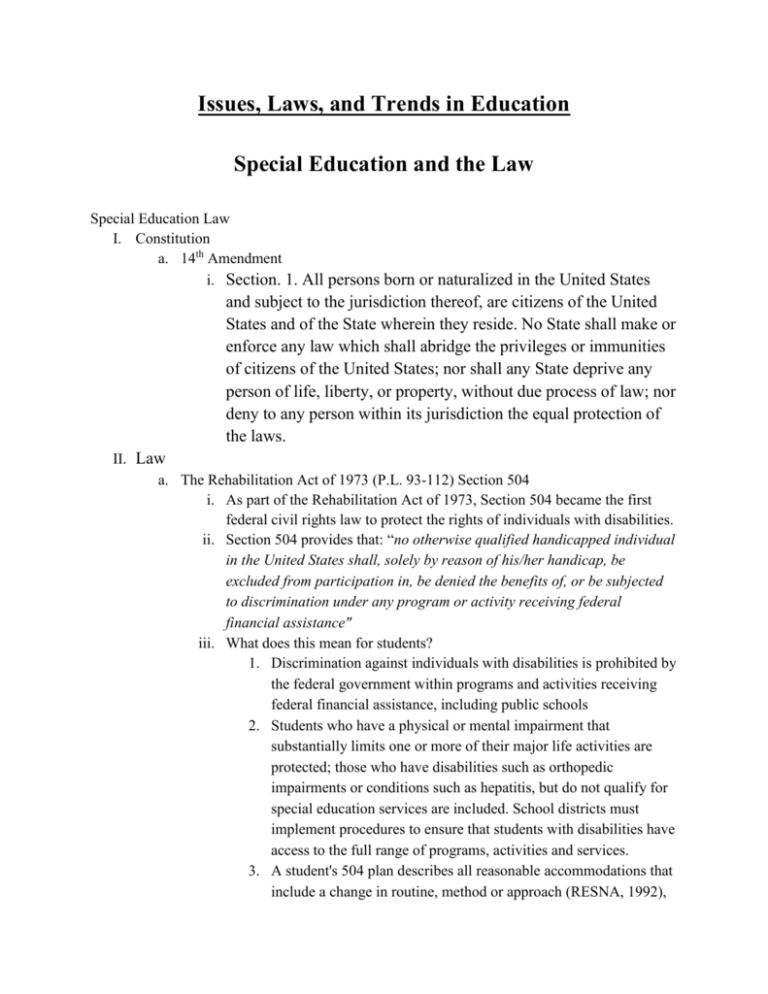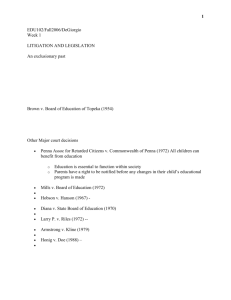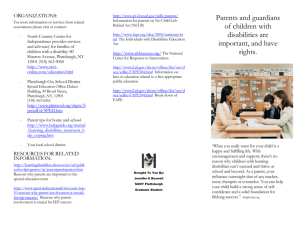Special Education and the Law
advertisement

Issues, Laws, and Trends in Education Special Education and the Law Special Education Law I. Constitution a. 14th Amendment i. Section. 1. All persons born or naturalized in the United States and subject to the jurisdiction thereof, are citizens of the United States and of the State wherein they reside. No State shall make or enforce any law which shall abridge the privileges or immunities of citizens of the United States; nor shall any State deprive any person of life, liberty, or property, without due process of law; nor deny to any person within its jurisdiction the equal protection of the laws. II. Law a. The Rehabilitation Act of 1973 (P.L. 93-112) Section 504 i. As part of the Rehabilitation Act of 1973, Section 504 became the first federal civil rights law to protect the rights of individuals with disabilities. ii. Section 504 provides that: “no otherwise qualified handicapped individual in the United States shall, solely by reason of his/her handicap, be excluded from participation in, be denied the benefits of, or be subjected to discrimination under any program or activity receiving federal financial assistance" iii. What does this mean for students? 1. Discrimination against individuals with disabilities is prohibited by the federal government within programs and activities receiving federal financial assistance, including public schools 2. Students who have a physical or mental impairment that substantially limits one or more of their major life activities are protected; those who have disabilities such as orthopedic impairments or conditions such as hepatitis, but do not qualify for special education services are included. School districts must implement procedures to ensure that students with disabilities have access to the full range of programs, activities and services. 3. A student's 504 plan describes all reasonable accommodations that include a change in routine, method or approach (RESNA, 1992), and must be stated on the IEP or a separate form. Examples such as changes in time requirements and testing accommodations are included as well as AT devices and services. b. Education for All Handicapped Children Act of 1975 (Public Law 94-142) i. In 1975, Congress passed Public Law 94-142 (Education of All Handicapped Children Act), now codified as IDEA (Individuals with Disabilities Education Act). In order to receive federal funds, states must develop and implement policies that assure a free appropriate public education (FAPE) to all children with disabilities. The state plans must be consistent with the federal statute, Title 20 United States Code Section 1400 et.seq. (20 USC 1400) ii. The Education for all Handicapped Children Acts is more commonly known as the EHA; it had as its purpose: 1. To guarantee a Free and Appropriate Public Education (FAPE) for all children with disabilities, ages 5-21 2. Special Education and related services must be free, provided by the public agency at no cost to the parents 3. Appropriate education is the provision of regular and special education and related services designed to meet students' individual educational needs. 4. To develop an Individualized Education Program (IEP) for each child eligible for special education and related services; plan is based on multi-disciplinary assessment and includes a statement of specific special education and related services to be provided to the child 5. To the maximum extent appropriate, all children and youth with disabilities will be educated in the least restrictive education (LRE) environment 6. Parents have the right to participate in every decision related to the identification, evaluation, and placement of their child. Parents must give consent for any initial evaluation, assessment or placement decision. Due process procedures assure parents rights to appeal. c. 1986 Amendments (P.L. 99-457) Preschool and Infant/Toddler Programs. In 1986, an amendment to the EHA, extended the purpose of EHA to include children ages 0-5 and included: i. To extend the guarantee to a Free and Appropriate Public Education (FAPE) to children with disabilities, ages 3-5. ii. To establish Early Intervention Programs (EIP) for infants and toddlers with disabilities, ages 0-2 iii. To develop an Individualized Family Service Plan (IFSP) for each family with an infant/toddler with disabilities d. 1990 Amendments (P.L. 101-476) - In 1990, amendments were again added to EHA, considerably adding components to the law: i. To rename the EHA as the Individuals with Disabilities Education Act (IDEA). The amendment also replaced the phrase "handicapped child" with "child with a disability". ii. To provide Transition Services for students by age 16 iii. To extend eligibility to children with autism and traumatic brain injury iv. To define Assistive Technology Devices and Services for children with disabilities for inclusion in the IEP v. To extend the Least Restrictive Environment (LRE) to require the child, to the maximum extent appropriate, be educated with children without disabilities -- in the same class s/he would have been but for the disability e. 1997 Amendments (P.L. 105-17) - 1997 amendments further strengthened the rights of students with disabilities. i. To extend LRE as an assurance that all students would have "access to the general curriculum" ii. To "consider" Assistive Technology Devices and Services on the IEP's of all students. Use of school-purchased AT in a child's home or other settings is required if the child needs access to those devices to receive FAPE. iii. To include orientation and mobility services to the list of related services for children who are blind or have visual impairments, as well as for other children who may also need instruction in traveling around their school, or to and from school. f. Americans with Disabilities Act, 1990 (P.L. 101-336) i. In 1990, the ADA was passed, giving full civil rights to all individuals with disabilities. It extends Section 504 by prohibiting discrimination in public and private sector employment, public accommodation, transportation, state and local government services and telecommunications. ii. For students with disabilities, the ADA prohibits discrimination and extends the right of access to ALL educational programs and services whether or not the school receives federal funding. III. Court Cases a. Pennsylvania Association for Retarded Children (PARC) v. Pennsylvania (1972) i. Recognized educational rights for children with disabilities. ii. Mentally retarded students ages 6-21 should be provided with access to a free public education and that children with disabilities should be placed in regular classes when possible or in special classes when necessary. b. Mills v. Board of Education of the District of Columbia (1972) i. Extended the PARC decision to all school age children with disabilities, holding that they must be provided with a free and adequate education. IV. Have students present their cases. a. PARC v. Pennsylvania b. Mills v Board of Ed of D.C. c. Board of Education of the Hendrick Hudson Central School District v. Rowley d. Timothy v. Rochester SD I. The History of Special Education Law a. Critical Event #1 i. Compulsory attendance laws ii. The exclusion of students with disabilities iii. Parental advocacy iv. Council for Exceptional Children, 1922 v. Cuyahoga Council for Retarded Children, 1933 vi. National Association for Retarded Citizens (The ARC), 1950 b. Critical Event #2 i. Brown v. Board of Education, 347 U.S. 483 (1954) 1. “In these days, it is doubtful that any child may reasonably be expected to succeed in life if he is denied the opportunity of an education. Such an opportunity, where the state has undertaken to provide it, is a right that must be available to all on equal terms.” -Chief Justice Earl Warrenc. Critical Event #3 i. Right to Education Cases ii. The Seminal Cases iii. Early Federal Involvement 1. The Elementary and Secondary Education Act of 1965 2. The Education of the Handicapped Act of 1970 3. Section 504 of the Rehabilitation Act of 1973 4. The Education Amendments of 1974 d. Critical Event #4 i. The Education for All Handicapped Children Act of 1975 (P.L. 94-142) ii. Six Principles of IDEA 1. Focus of EAHCA 2. To ensure access to public education for students with disabilities 3. Reauthorizations of the EAHCA 4. 1986 The Handicapped Children’s Protection Act 5. 1990 The Infants & Toddlers with Disabilities Act 6. 1997 The Individuals with Disabilities Education Act 7. The Individuals with Disabilities Education Act Amendments of 1997 e. Critical Event #5 i. Board of Education v. Rowley 458, U.S. 176 (1982) 1. Free Appropriate Public Education “We hold that the state satisfies the FAPE requirement by providing personalized instruction with sufficient support services to permit the child to benefit educationally from that instruction” (Rowley, pp. 203-204) ii. The Rowley Twofold Inquiry 1. Has the state complied with the procedures in the act? 2. Is the IEP reasonably calculated to enable the child to receive educational benefits? f. Critical Event #6 i. The Individuals with Disabilities Education Act Amendments of 1997 (IDEA '97) ii. The underlying theme of IDEA '97 was to improve the effectiveness of special education by requiring demonstrable improvements in the educational achievement of students with disabilities iii. Goal of IDEA '97 “To move to the next step in providing special education: To improve and increase educational achievement of students with disabilities” H.R. 10595 g. Critical Event #6 i. The No Child Left Behind Act of 2001 ii. NCLB Accountability NCLB focuses on: •Increasing the academic achievement of all public school students •Improving the performance of low-performing schools •Requiring schools to adopt scientifically based instructional practices NCLB accomplishes this by: • Requiring states to measure the progress of students and groups of students, including students with disabilities, every year •Reporting the results of these measures to parents •Requiring states to set proficiency standards that schools must attain within a set period of time h. Important Things to Understand About NCLB i. NCLB is a reaction to low academic achievement in America’s students ii. NCLB is sweeping legislation that will exert a profound influence on education iii. NCLB recognizes and embraces science iv. NCLB will affect the ways that universities prepare teachers and teachers teach their students v. NCLB is here to stay (although there will be modifications to the law) i. Critical Event #7 i. President’s Commission on Excellence in Special Education: A new era: Revitalizing special education for children and their families (11/2/01) ii. Major Findings • • • • • •iii. • • Process and compliance are often placed above results The wait-to-fail model of special education prevents prevention Lack of scientifically based approaches in general education results in inappropriate placements A culture of compliance results in too much attention has been diverted from the first mission of schools: educating every child Many of the current methods of identifying children with disabilities lack validity & many children are misidentified The current system does not always embrace evidence-based practices, Major Recommendations Focus on results—not on process: The IDEA must retain the legal and procedural safeguards necessary to guarantee a FAPE while providing opportunities and improved student outcomes Embrace a model of prevention not a model of failure: Special education must move toward early identification and swift intervention using scientifically based instruction and teaching methods • Consider children with disabilities as general education children first: General and special education must work together to provide effective teaching because both systems share responsibilities for children with disabilities j. Critical Event #8 i. The Individuals with Disabilities Education Improvement Act of 2004 ii. Focus of IDEA 2004 1. To increase the academic achievement of students in special education 2. Focus on writing measurable goals and actually measuring them 3. Focus on progress monitoring 4. To increase accountability for results 5. To streamline the special education process k. Challenges to Special Education i. Conduct relevant assessments of students’ educational needs ii. Implement research-based instructional programming, based on these assessments, that confers meaningful educational benefit iii. Monitor students’ progress using data- based formative evaluation systems iv. Changes in Special Education Law II. The History of Special Education Law a. Critical Event #1 i. Compulsory attendance laws ii. The exclusion of students with disabilities iii. Parental advocacy iv. Council for Exceptional Children, 1922 1. To unite those interested in educational problems of"special children" 2. To emphasize the education of "special children" rather thanhis/her identification 3. To establish professional standards for teachers in thefield of special education. v. Cuyahoga Council for Retarded Children, 1933 vi. National Association for Retarded Citizens (The ARC), 1950 b. Critical Event #2 i. Brown v. Board of Education, 347 U.S. 483 (1954) 1. “In these days, it is doubtful that any child may reasonably be expected to succeed in life if he is denied the opportunity of an education. Such an opportunity, where the state has undertaken to provide it, is a right that must be available to all on equal terms.” -Chief Justice Earl Warrenc. Critical Event #3 i. Right to Education Cases 1. PARC v. PA 2. Mills v District of Columbia Board of Ed. ii. Early Federal Involvement 1. The Elementary and Secondary Education Act of 1965 2. The Education of the Handicapped Act of 1970 3. Section 504 of the Rehabilitation Act of 1973 4. The Education Amendments of 1974 d. Critical Event #4 i. The Education for All Handicapped Children Act of 1975 (P.L. 94-142) ii. Six Principles of IDEA 1. Zero Reject - Locate, identify, & provide services to all eligible students with disabilities 2. Protection in Evaluation- Conduct an assessment to determine if a student has an IDEA related disability and if he/she needs special education services 3. Free Appropriate Public Education - Develop and deliver an individualized education program of special education services that confers meaningful educational benefit. 4. Least Restrictive Environment - Educate students with disabilities with nondisabled students to the maximum extent appropriate. 5. Procedural Safeguards - Comply with the procedural requirements of the IDEA. 6. Parental Participation - Collaborate with parents in the development and delivery of their child’s special education program. iii. Focus of EAHCA 1. To ensure access to public education for students with disabilities iv. Reauthorizations of the EAHCA 1. 1986 The Handicapped Children’s Protection Act 2. 1986 The Infants & Toddlers with Disabilities Act 3. 1990 The Individuals with Disabilities Education Act 4. 197 The Individuals with Disabilities Education Act Amendments of 1997 e. Critical Event #5 i. Board of Education v. Rowley 458, U.S. 176 (1982) 1. Free Appropriate Public Education “We hold that the state satisfies the FAPE requirement by providing personalized instruction with sufficient support services to permit the child to benefit educationally from that instruction” (Rowley, pp. 203-204) ii. The Rowley Twofold Inquiry 1. Has the state complied with the procedures in the act? 2. Is the IEP reasonably calculated to enable the child to receive educational benefits? f. Critical Event #6 i. The Individuals with Disabilities Education Act Amendments of 1997 (IDEA '97) ii. The underlying theme of IDEA '97 was to improve the effectiveness of special education by requiring demonstrable improvements in the educational achievement of students with disabilities iii. Goal of IDEA '97 “To move to the next step in providing special education: To improve and increase educational achievement of students with disabilities” H.R. 10595 g. Critical Event #6 i. The No Child Left Behind Act of 2001 ii. NCLB Accountability NCLB focuses on: •Increasing the academic achievement of all public school students •Improving the performance of low-performing schools •Requiring schools to adopt scientifically based instructional practices NCLB accomplishes this by: • Requiring states to measure the progress of students and groups of students, including students with disabilities, every year •Reporting the results of these measures to parents •Requiring states to set proficiency standards that schools must attain within a set period of time h. Important Things to Understand About NCLB i. NCLB is a reaction to low academic achievement in America’s students ii. NCLB is sweeping legislation that will exert a profound influence on education iii. NCLB recognizes and embraces science iv. NCLB will affect the ways that universities prepare teachers and teachers teach their students v. NCLB is here to stay (although there will be modifications to the law) i. Critical Event #7 i. President’s Commission on Excellence in Special Education: A new era: Revitalizing special education for children and their families (11/2/01) ii. Major Findings • • • • • •iii. Process and compliance are often placed above results The wait-to-fail model of special education prevents prevention Lack of scientifically based approaches in general education results in inappropriate placements A culture of compliance results in too much attention has been diverted from the first mission of schools: educating every child Many of the current methods of identifying children with disabilities lack validity & many children are misidentified The current system does not always embrace evidence-based practices, Major Recommendations • • Focus on results—not on process: The IDEA must retain the legal and procedural safeguards necessary to guarantee a FAPE while providing opportunities and improved student outcomes Embrace a model of prevention not a model of failure: Special education must move toward early identification and swift intervention using scientifically based instruction and teaching methods • Consider children with disabilities as general education children first: General and special education must work together to provide effective teaching because both systems share responsibilities for children with disabilities j. Critical Event #8 i. The Individuals with Disabilities Education Improvement Act of 2004 ii. Focus of IDEA 2004 1. To increase the academic achievement of students in special education 2. Focus on writing measurable goals and actually measuring them 3. Focus on progress monitoring 4. To increase accountability for results 5. To streamline the special education process k. Challenges to Special Education i. Conduct relevant assessments of students’ educational needs ii. Implement research-based instructional programming, based on these assessments, that confers meaningful educational benefit iii. Monitor students’ progress using data- based formative evaluation systems iv. Changes in Special Education Law: Started with issues of access and has developed into issues of quality.







